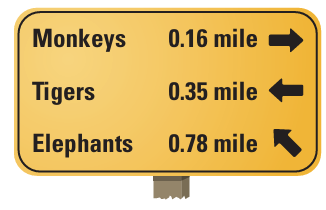CONVERTING THE DECIMALS AS FRACTION
Subscribe to our ▶️ YouTube channel 🔴 for the latest videos, updates, and tips.
Here we see how to convert the terminating decimals to fraction.
To convert terminating decimal to fraction,
- We have to notice, the number of digits after the decimal.
- Based on the number of digits after the decimal, we may have to choose 10, 100, 1000, ...... etc.
- Multiply the numerator and denominator by 10n. Here n will represent the number of digits after the decimal.
- After we get rid of the decimal and made it as integer at the numerator, we can move the decimal backwards n digits.
Change the following decimal numbers to fractions or mixed numbers. Reduce answers, if possible.
Problem 1 :
0.25
Solution :
Number of digits after the decimal point is 2.
So, we have to multiply both numerator and denominator by 100.
Problem 2 :
0.2
Solution :
Number of digits after the decimal point is 1.
So, we have to multiply both numerator and denominator by 10.
Problem 3 :
3.8
Solution :
Number of digits after the decimal point is 1.
So, we have to multiply both numerator and denominator by 10.
Problem 4 :
0.75
Solution :
Number of digits after the decimal point is 2.
So, we have to multiply both numerator and denominator by 100.
Problem 5 :
0.16
Solution :
Number of digits after the decimal point is 2.
So, we have to multiply both numerator and denominator by 100.
Problem 6 :
0.625
Solution :
Number of digits after the decimal point is 3.
So, we have to multiply both numerator and denominator by 1000.
Problem 7 :
16.31
Solution :
Number of digits after the decimal point is 2.
So, we have to multiply both numerator and denominator by 100.
Problem 8 :
3.35
Solution :
Number of digits after the decimal point is 2.
So, we have to multiply both numerator and denominator by 100.
Problem 9 :
0.07
Solution :
Number of digits after the decimal point is 2.
So, we have to multiply both numerator and denominator by 100.
Problem 10 :
0.1875
Solution :
Number of digits after the decimal point is 4.
So, we have to multiply both numerator and denominator by 10000.
Problem 11 :
42.325
Solution :
Number of digits after the decimal point is 3.
So, we have to multiply both numerator and denominator by 1000.
Problem 12 :
7.37
Solution :
Number of digits after the decimal point is 2.
So, we have to multiply both numerator and denominator by 100.
Problem 13 :
Write the value of the money as a decimal and as a fraction of a dollar.
a) one nickel
b) one quarter
c) eight pennies
d) one dollar and six dimes
Solution :
a)
1 dollar = 100 cents
one nickle = 5 cents
Converting into dollar,
= 5/100
= 1/20 dollars
b)
1 dollar = 100 cents
one quarter = 25 cents
Converting into dollar,
= 25/100
= 1/4 dollars
c)
1 dollar = 100 pennies
Converting 8 pennies into dollar,
= 8/100
= 2/25 dollars
d)
1 dollar = 100 cents
1 dimes = 10 cents
6 dimes = 60 cents
Converting 1 dollar and 6 dimes to dollars
= 60/100
= 3/5 dollars
Problem 14 :
The Henry E. Kinney Tunnel in Fort Lauderdale is the only underwater tunnel on public land in Florida. It has a length of 41/250 mile. The average length of a car is 0.003 mile. How many cars can fit in one lane of the tunnel bumper to bumper?
Solution :
Length of tunnle = 41/250 mile
Average length of car = 0.003 miles
Number of cars can be fit on the tunnle = 41/250 / 0.003
= (41/250) / (3/1000)
= 41/250 x (1000/3)
= 54.6
So approximately 55 cars.
Problem 15 :

The sign shows the distances to several zoo exhibits.
a. Write the distances as fractions.
b. How many times farther is the elephant exhibit than the monkey exhibit?
c. The manatee exhibit is 3 times farther than the tiger exhibit. How far is the manatee exhibit?
Solution :
a. Distances as fraction,
- Monkeys = 16/100 miles
- Tigers = 35/100 miles
- Elephants = 78/100 miles
b. Difference between elephant exhibit than the monkey exhibit
= 78/100 - 16/100
= (78 - 16)/100
= 62/100
= 0.62 miles
c.
The distance of manatee exhibit = 3(35/100)
= 105/100
= 1.05 miles
Problem 16 :
A basketball player’s 3-point average is the number of 3-point shots made divided by the number of attempts.
a. A player’s 3-point average is 0.36. How could this happen?
b. If the player in part (a) attempted 350 shots, how many shots did the player make?
Solution :
a)
0.36 = 36/100
= 9/25
For every 25 shots he made 9 shots.
b)
350 shots = (9/25) x 350
= 126 shots
Subscribe to our ▶️ YouTube channel 🔴 for the latest videos, updates, and tips.
Recent Articles
-
Finding Range of Values Inequality Problems
May 21, 24 08:51 PM
Finding Range of Values Inequality Problems -
Solving Two Step Inequality Word Problems
May 21, 24 08:51 AM
Solving Two Step Inequality Word Problems -
Exponential Function Context and Data Modeling
May 20, 24 10:45 PM
Exponential Function Context and Data Modeling